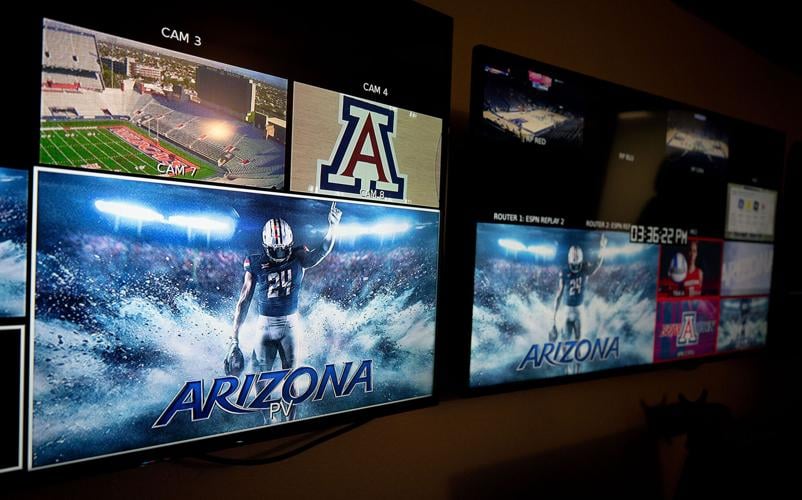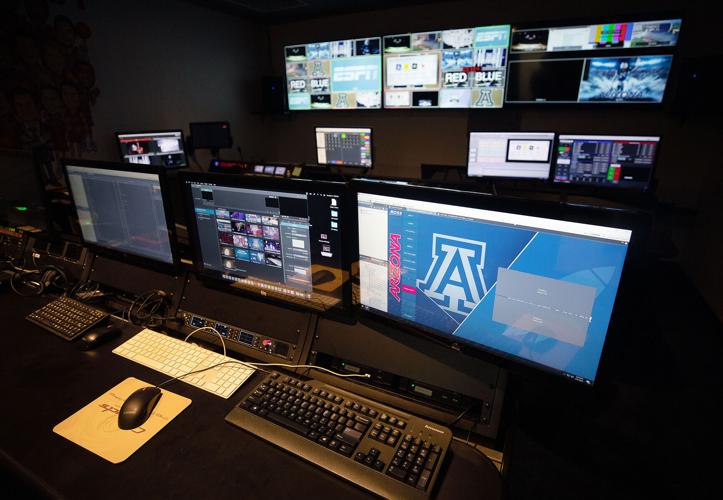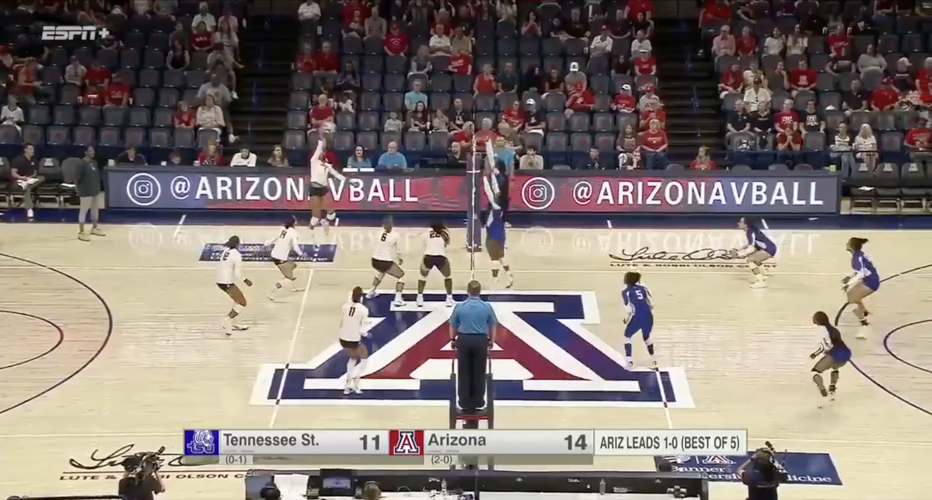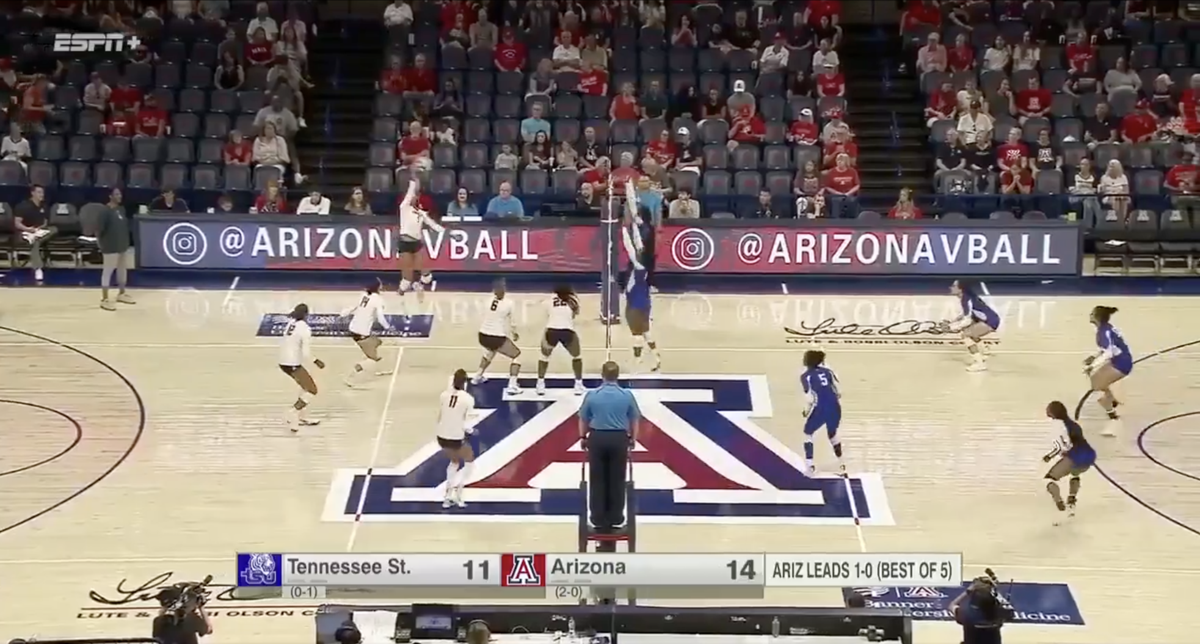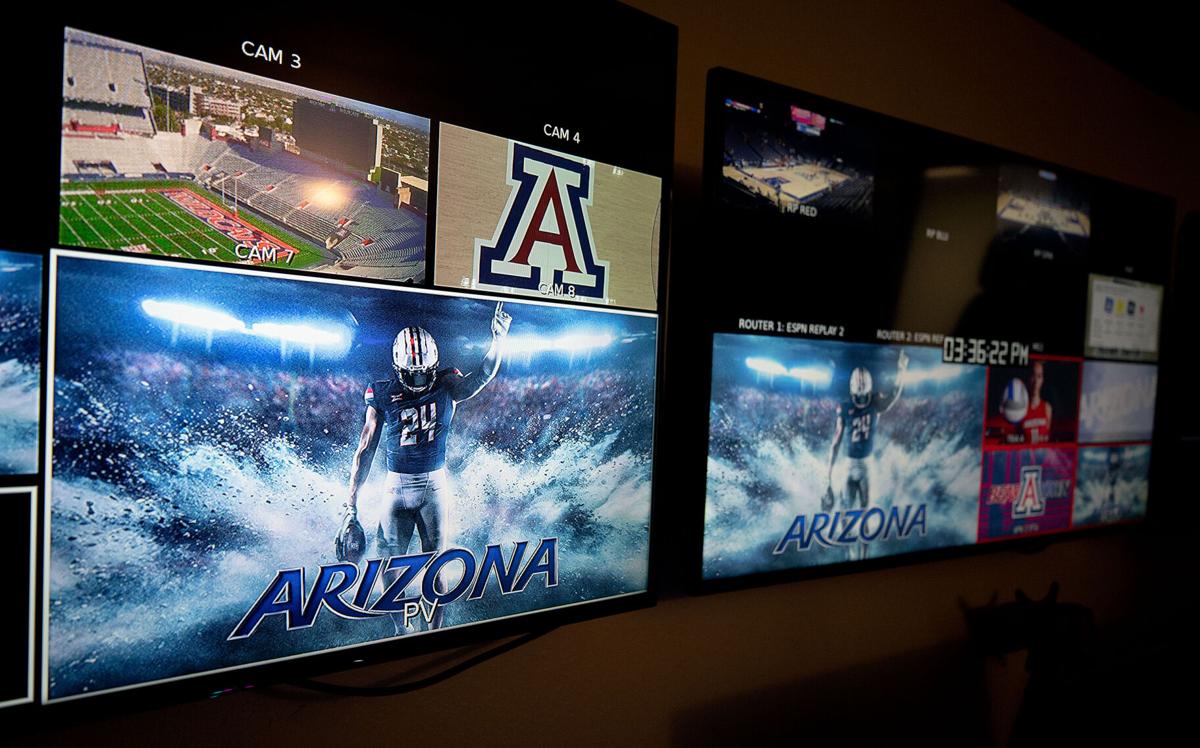We’re walking through the labyrinth that is McKale Center. Just around the corner from the Lute & Bobbi Olson Court, down a hallway, we are guided to a room filled with monitors, keyboards, headsets and other fancy-looking equipment.
If you’ve ever seen the inside of a television production truck, it pretty much looks like this. That’s the idea.

Michael Lev is a senior writer/columnist for the Arizona Daily Star, Tucson.com and The Wildcaster.
This is where the magic happens. In this room (the broadcast control room) and the one next to it (the video board control room), about 25 people enabled the University of Arizona to produce its first streaming broadcast on ESPN+ — the volleyball match this past Friday between Arizona and Boise State.
“For the amount of work that went on behind the scenes, a project that started 6-9 months ago, to see it come to fruition, to see it come (off) as well as we hoped ... we felt like we put our best foot forward,” said John Daley, Arizona’s assistant athletic director, creative services.
The UA will produce 50 events for ESPN+ this academic year, and that number will “more than double” starting next year, Daley said.

John Daley, assistant athletic director, creative services, poses inside the broadcast control room at McKale Center on the University of Arizona campus on Sept. 3, 2024.
The Wildcats’ football game against Northern Arizona on Saturday will be broadcast on ESPN+, although Daley and his team won’t produce that one. More likely than not, a handful of UA football games will “air” on ESPN+ each season moving forward. So will many men’s basketball games. And ESPN+ will be the primary home for UA women’s basketball, among other sports.
It’s a big change for Arizona and the three other “Four Corners” schools — ASU, Colorado and Utah — who joined the Big 12 Conference this summer. For fans — and even the so-called experts in the media — navigating that change can be challenging and confusing. We all just want to watch the game, and we don’t want to spend a lot of time, if any, figuring out how to do that.
What follows is a hopefully helpful guide to all things ESPN+, including how to get it; what the UA had to do to get up to speed; and what the broadcast landscape will look like moving forward for Arizona’s “non-revenue” sports.
What is ESPN+, and why are Arizona’s athletic events appearing on this platform? ESPN+ is ESPN’s subscription streaming service. Its offerings include live sporting events, original programming, on-demand programming and “premium” articles on ESPN.com.
Since 2012, if an Arizona football or basketball game didn’t appear on “linear TV,” it aired on the Pac-12 Networks — which also televised numerous events in the non-revenue or “Olympic” sports.
That relationship ended in June, when the last Pac-12 sporting event was played — the baseball tournament in Scottsdale. The Big 12 doesn’t have its own network but is one of about 30 conferences whose games appear on ESPN+.
The Big 12’s media contract is with ESPN and FOX. Most UA football and men’s basketball games will air on those networks or their subsidiaries such as ESPN2 or FS1. The Big 12’s six-year contract extension with ESPN and FOX starts in 2025 and will pay each school about $31.7 million annually.
If I don’t have it already, how do I get ESPN+?
From a consumer standpoint, one of the main advantages of going from Pac-12 Networks to ESPN+ is that anybody can get it. It doesn’t matter what cable or satellite package you have. It doesn’t matter if you’ve cut the cord. It doesn’t matter where you live in the U.S.
ESPN+ can be purchased as a standalone product for $10.99 a month. It’s also available as a bundle with Disney+ and Hulu for $14.99 a month with ads or $24.99 without ads. (The latter — no ads — only applies to Disney+ and Hulu.)
You can access ESPN+ through the ESPN app, which is available on any number of streaming devices such as Roku or Amazon’s Fire TV Stick. If you have one of those devices hooked up to your flat screen — or you have a “smart TV” — you can watch Saturday’s football game just as you normally would.

A button lights up on a board inside the broadcast control room at McKale Center on the University of Arizona campus on Sept. 3, 2024.
I asked Daley, a longtime UA employee and alum, what he tells his friends when they ask him that question.
“Honestly, a lot of people have ESPN+ and don’t even realize it,” Daley said.
He suggested using the voice command button on your remote and saying, “ESPN+.” That should take you to the app. Once there, you can sign up for the service.
I already have ESPN and I’m paying for cable — and it’s not cheap. Now I have to pay for something else?
Unfortunately, that’s the reality. But compared to a lot of other content packages, you get a lot of bang for your buck.
The ESPN+ subscription gives you access to every game that’s broadcast on the platform, and it’s not limited to college sports. ESPN+ also broadcasts live MLB and NHL games, PGA tournaments, UCF bouts and professional soccer matches. You can watch those events on any of your devices (smartphone, tablet, laptop) and you can stream on up to five devices simultaneously for “most ESPN+ content,” according to the ESPN+ online support page.
What did the UA have to do to be in position to broadcast these events on ESPN+?
Daley and his team — including IT gurus Jeff Kohler and Ryan Bloom — started talking about it last summer, when rumors of Arizona’s move to the Big 12 were gaining traction.
The broadcast control room already existed, but it needed to be upgraded and retrofitted. Its primary purpose previously was handling production for the video boards at Arizona Stadium and McKale Center. Now the UA needed to produce that content as well as volleyball matches and basketball games.
“The physical parts of the room really didn’t change,” Daley said. “It’s the brains, it’s all the equipment.”
The broadcast control room and the video board control room sandwich those “brains.” In TV parlance, they call that space the “rack room.” The black “racks” resemble computer towers. Stacked in a long row standing about 6 feet high, with countless buttons and wires, the racks look like something you’d see at Mission Control.

Arizona events not aired on broadcast or cable television (such as ABC, FOX, FS1 or the ESPN networks) are most likely to be distributed via 'Big 12 Now' on the ESPN+ paid-subscription streaming platform.
The construction and installation couldn’t begin until late May after the UA’s commencement ceremony at Arizona Stadium (which utilizes the video board). A scheduled power outage shut down McKale Center for a week in July, tightening the timeline. The original goal was to be up and running by Aug. 14. The first unofficial event run through the new video board control room was the “Destination Arizona” new-student orientation on Aug. 24 at McKale Center.
“That was just two wireless cameras,” Daley noted. And campus provided all the content.
The first volleyball match was a much bigger undertaking. Every ESPN+ broadcast has to meet ESPN’s standards. That means, in most cases, announcers, multiple cameras, replays and graphics packages.
“It is very important for the broadcasts on ESPN+ to meet the ESPN minimum specs,” said Justin Nusser, senior director — media programming & production for the Big 12. “As all of these are national broadcasts, we want to ensure they can look as close to linear productions as possible.”
Although the football game Saturday is airing on ESPN+, ESPN is handling the production and will have a truck onsite.
How much money did the school have to spend to make this happen?
A UA spokesman declined to provide a specific number, other than to say it was north of $1 million and “well south” of the $8 million that Louisville spent to build a 7,850-square-foot broadcast center in 2018 (in advance of the ACC Network’s launch in 2019).
The average cost to build a modern control room is about $2.5 million, said Major Howe, who works for UCF as the school’s associate athletics director, production. Howe previously worked as a remote director for ESPN and has 20-plus years of experience in TV production.
Neither ESPN nor the Big 12 provides any financial assistance above and beyond the $31.7 million in rights fees. So it’s up to the member schools to cover the costs. Some purchases, such as equipment, are “upfront” or “one time only” (at least until something breaks or becomes outdated). Others, such as the production crew and announcers, are ongoing. (Steve Quis and Makenna Martin called the first volleyball match.)

The broadcast control room inside McKale Center on the University of Arizona cmapus on Sept. 3, 2024.
The upside for the schools is threefold: (1) ESPN+ provides exposure for the institutions and their brands; (2) it provides a platform to tell their students-athletes’ stories; and (3) producing games in-house gives aspiring directors and camera operators real-life experience. (One of Howe’s students, who graduated in May, got a freelance job with ESPN and was part of the production team for the UA-New Mexico game last week.)
One other potential upside is leasing the control room to a network such as ESPN or FOX for, say, a men’s basketball game. It wouldn’t come close to recouping all the costs, but it’s something.
“That’s the ultimate goal,” Daley said. “This is built to be the equivalent of a (production) truck.”
What about UA home games that aren’t played at McKale Center?
Starting next school year, the UA will be required to produce all home soccer, volleyball, men’s and women’s basketball, gymnastics, baseball and softball events not selected by one of the Big 12’s media partners. In other words, almost all of them.
The UA currently doesn’t have the infrastructure to produce broadcasts of events off campus the way that it did the volleyball match against Boise State. Until it gets to that point, baseball and softball streams might be limited to one-camera setups with no replays. They’ll still fall under the ESPN+ umbrella, though.
Arizona streamed 148 events for “free” in 2023-24. Those days are over.


